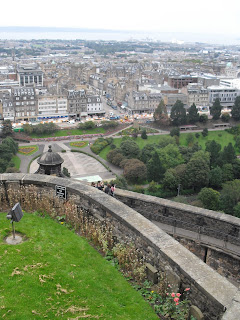
Justin and I joined up with a trip sponsored by the Edinburgh University History Society that got us discounted admission to Edinburgh Castle, site of much history and many tourists. Unfortunately, this trip and tour were a long time ago, and I've been remiss in getting them posted, so I have no idea how much I'll remember.
Edinburgh Castle sits high above the city of Edinburgh. How high, you ask, especially Justin's skeptical Pittsburgh relations, whose driveways frequently rate as black diamonds come winter?


That high. I think even Pittsburghers must be impressed.
With the hill, and the commanding view of the water, one can therefore guess that this has been an important defensive position for a significant period of time. One would be correct. Way to go, one! According to the castle web site, the oldest evidence of human settlement on the castle hilltop dates back to 900 BC, with the fortress "Din Eidyn" ("Edwin's Fort") first appearing around 600 BC.
(Side note to Tolkein nerds: Din Eidyn... Dunedain. Warrior men of the North. Make your own call).
The oldest building on site, going back to 1130, is St. Margaret's Chapel, a tiny whitewashed stone room dedicated to the former queen of Scotland. You can just make it out on the far right of this image here. See how the texture of the stone is rougher?

Nearby you can find Mons Meg, a 550 year old medieval siege gun built at Mons, Belgium, and quite frankly not something I would have liked to have had to lug up the hill. I am, however, perfectly happy to pose around it in various undignified ways.


Nor would I have liked to have lugged the ammunition.

The castle was the site of several important battles during what Americans best know as "the Braveheart period," AKA the reign of Edwards I through III. (As our tour guide at the castle put it, "There are three types of movies: movies which tell the history, movies which are based on the history but take some liberties, and movies which make no attempt at historical accuracy whatsoever. Braveheart falls into the third category.") The relevance of the castle at this time is demonstrated by the following text from the castle web site:
1296
Edward I of England invades Scotland, capturing the
castle after a three-day siege.
1314
The Scots, under Robert the Bruce, recapture the castle.
1334
The English retake the castle.
1341
The Scots take it back again.
If I recall correctly, at least one of these sieges involved people boiling human waste to fling down on the enemy at the castle gates. Hey, why waste oil or pitch?
The Great Hall was built in 1511. Justin and I spent most of the time in there having flashbacks to Yale College dining halls, and wondering if we had remembered to swipe our meal cards.

 (That's Edinburgh Castle at the top, Yale below).
(That's Edinburgh Castle at the top, Yale below).King James I of England (James VI of Scotland, which, let's face it, is pretty irritating to keep track of) was born at the castle, in a tiny little chamber which we did not photograph, as indoor photography is frowned upon. It was tiny, and entirely paneled in painted wood, with a nice view down off the hill that I bet his mother Mary got awfully tired of while stuck in there in labor.
As they did at many UK historical sites, the Victorians took it upon themselves to improve upon the original. Here, you can see how a medieval wall becomes, halfway up, a Victorian addition:

The castle is also home to the Scottish National War Memorial

and the Honours (with a U!) of Scotland, which in English means the crown, sceptre (not scepter!), and sword of the monarchs of Scotland, along with some really nice royal jewelry. It is an interesting quirk of history, I think, that Scotland maintained its independence in the wake of the wars mentioned above - the not-really Braveheart wars. It was only after James VI went over to become James I (I told you that would be annoying) that the shenanigans started. You would think that a Scottish family on the throne of England would be good news for the Scots, but alas, it was not to be. (Although in all fairness, you could probably say that the problems really began when the Scottish family came off the throne; see Justin's earlier post for review. There will be a quiz.)

Yes, that's me in the lower right. Do you think I would make a good guard? See how vigilant I am!
 On second thought, no. It was too cold.
On second thought, no. It was too cold. 
So when did they lose the Stone of Scone?
ReplyDeleteGreat history lesson. Nice pics, too.
ReplyDeleteAh, the Stone of Scone (sadly pronounced "Stone of Scoone" and therefore not as rap-friendly as one might wish).
ReplyDeleteOstensibly captured by Edward I in 1296, ostensibly returned to Scotland in 1996. (Ostensibly because there are many legends surrounding it being switched with other stones along the way). It's now housed with the Honours of Scotland and will return to London for any future coronations, although accordint to our tour guide, they're sending it tied to a long piece of string ("We're not waiting 700 years to get it back this time!")
See here: http://www.edinburghcastle.gov.uk/index/tour/highlights/highlights-stone-of-destiny.htm